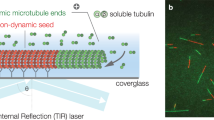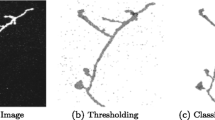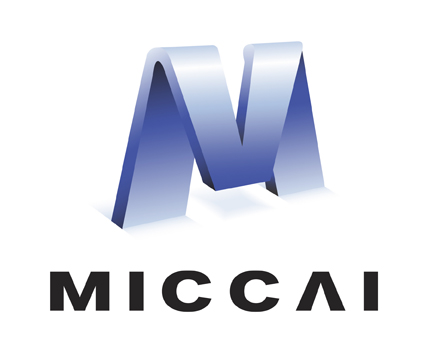Abstract
We present a method for microtubule tracking in electron microscopy volumes. Our method first identifies a sparse set of voxels that likely belong to microtubules. Similar to prior work, we then enumerate potential edges between these voxels, which we represent in a candidate graph. Tracks of microtubules are found by selecting nodes and edges in the candidate graph by solving a constrained optimization problem incorporating biological priors on microtubule structure. For this, we present a novel integer linear programming formulation, which results in speed-ups of three orders of magnitude and an increase of 53% in accuracy compared to prior art (evaluated on three \(1.2\times 4\times 4\,\upmu \)m volumes of Drosophila neural tissue). We also propose a scheme to solve the optimization problem in a block-wise fashion, which allows distributed tracking and is necessary to process very large electron microscopy volumes. Finally, we release a benchmark dataset for microtubule tracking, here used for training, testing and validation, consisting of eight \(30 \times 1000 \times 1000\) voxel blocks (\(1.2\times 4\times 4\,\upmu \)m) of densely annotated microtubules in the CREMI data set (https://github.com/nilsec/micron).
Access this chapter
Tax calculation will be finalised at checkout
Purchases are for personal use only
Similar content being viewed by others
Notes
- 1.
Resolution is around \(4\times 4 \times 40\) nm for ssTEM, and \(8\times 8 \times 8\) nm for FIB-SEM [20].
- 2.
MICCAI Challenge on Circuit Reconstruction in EM Images, https://cremi.org.
- 3.
We use our ILP formulation, which was necessary to process larger volumes.
- 4.
Orientation estimate used in [4] (direct communication with authors).
References
Boergens, K.M., et al.: Webknossos: efficient online 3d data annotation for connectomics. Nat. Methods 14(7), 691–694 (2017)
Buhmann, J., et al.: Synaptic partner prediction from point annotations in insect brains. In: Frangi, A.F., Schnabel, J.A., Davatzikos, C., Alberola-López, C., Fichtinger, G. (eds.) MICCAI 2018. LNCS, vol. 11071, pp. 309–316. Springer, Cham (2018). https://doi.org/10.1007/978-3-030-00934-2_35
Buhmann, J., et al.: Automatic detection of synaptic partners in a whole-brain drosophila em dataset. bioRxiv (2019). https://doi.org/10.1101/2019.12.12.874172
Buhmann, J.M., Gerhard, S., Cook, M., Funke, J.: Tracking of microtubules in anisotropic volumes of neural tissue. In: 2016 IEEE 13th International Symposium on Biomedical Imaging (ISBI) (2016). https://doi.org/10.1109/isbi.2016.7493275
Cheng, H.C., Varshney, A.: Volume segmentation using convolutional neural networks with limited training data. In: 2017 IEEE International Conference on Image Processing (ICIP), pp. 590–594. IEEE (2017)
Dorkenwald, S., et al.: Automated synaptic connectivity inference for volume electron microscopy. Nat. Methods 14(4), 435–442 (2017)
Funke, J., et al.: Large scale image segmentation with structured loss based deep learning for connectome reconstruction. IEEE Trans. Pattern Anal. Mach. Intell., 1 (2018). https://doi.org/10.1109/TPAMI.2018.2835450
Gittes, F., Mickey, B., Nettleton, J., Howard, J.: Flexural rigidity of microtubules and actin filaments measured from thermal fluctuations in shape. J. Cell Biol. 120(4), 923–934 (1993)
Heinrich, L., Funke, J., Pape, C., Nunez-Iglesias, J., Saalfeld, S.: Synaptic cleft segmentation in non-isotropic volume electron microscopy of the complete Drosophila brain. In: Frangi, A.F., Schnabel, J.A., Davatzikos, C., Alberola-López, C., Fichtinger, G. (eds.) MICCAI 2018. LNCS, vol. 11071, pp. 317–325. Springer, Cham (2018). https://doi.org/10.1007/978-3-030-00934-2_36
Huang, G.B., Scheffer, L.K., Plaza, S.M.: Fully-automatic synapse prediction and validation on a large data set. Frontiers Neural Circuits 12, 87 (2018)
Januszewski, M., et al.: High-precision automated reconstruction of neurons with flood-filling networks. Nat. Methods, 1 (2018)
Kreshuk, A., Funke, J., Cardona, A., Hamprecht, F.A.: Who is talking to whom: synaptic partner detection in anisotropic volumes of insect brain. In: Navab, N., Hornegger, J., Wells, W.M., Frangi, A.F. (eds.) MICCAI 2015. LNCS, vol. 9349, pp. 661–668. Springer, Cham (2015). https://doi.org/10.1007/978-3-319-24553-9_81
Lee, K., Lu, R., Luther, K., Seung, H.S.: Learning Dense Voxel Embeddings for 3D Neuron Reconstruction. arXiv e-prints arXiv:1909.09872, September 2019
Lee, K., Zung, J., Li, P., Jain, V., Seung, H.S.: Superhuman accuracy on the snemi3d connectomics challenge. arXiv preprint arXiv:1706.00120 (2017)
Nogales, E.: Structural insights into microtubule function. Annu. Rev. Biochem. 69(1), 277–302 (2000)
Ronneberger, O., Fischer, P., Brox, T.: U-net: convolutional networks for biomedical image segmentation. In: Navab, N., Hornegger, J., Wells, W.M., Frangi, A.F. (eds.) MICCAI 2015. LNCS, vol. 9351, pp. 234–241. Springer, Cham (2015). https://doi.org/10.1007/978-3-319-24574-4_28
Schneider-Mizell, C.M., et al.: Quantitative neuroanatomy for connectomics in drosophila. eLife 5, e12059 (2016)
Sommer, C., Straehle, C.N., Koethe, U., Hamprecht, F.A., et al.: Ilastik: Interactive learning and segmentation toolkit. In: ISBI, vol. 2, p. 8 (2011)
Staffler, B., et al.: Synem, automated synapse detection for connectomics. Elife 6, e26414 (2017)
Takemura, S.y., et al.: Synaptic circuits and their variations within different columns in the visual system of drosophila. Proc. Nat. Acad. Sci. 112(44), 13711–13716 (2015)
Xiao, C., et al.: Automatic mitochondria segmentation for EM data using a 3D supervised convolutional network. Frontiers Neuroanat. 12, 92 (2018). https://doi.org/10.3389/fnana.2018.00092. https://www.frontiersin.org/article/10.3389/fnana.2018.00092
Zheng, Z., et al.: A complete electron microscopy volume of the brain of adult drosophila melanogaster. Cell 174(3), 730–743 (2018)
Acknowledgements
We thank Tri Nguyen and Caroline Malin-Mayor for code contribution; Arlo Sheridan for helpful discussions and Albert Cardona for his contagious enthusiasm and support. This work was supported by Howard Hughes Medical Institute and Swiss National Science Foundation (SNF grant 205321L 160133).
Author information
Authors and Affiliations
Corresponding author
Editor information
Editors and Affiliations
1 Electronic supplementary material
Below is the link to the electronic supplementary material.
Rights and permissions
Copyright information
© 2020 Springer Nature Switzerland AG
About this paper
Cite this paper
Eckstein, N., Buhmann, J., Cook, M., Funke, J. (2020). Microtubule Tracking in Electron Microscopy Volumes. In: Martel, A.L., et al. Medical Image Computing and Computer Assisted Intervention – MICCAI 2020. MICCAI 2020. Lecture Notes in Computer Science(), vol 12265. Springer, Cham. https://doi.org/10.1007/978-3-030-59722-1_10
Download citation
DOI: https://doi.org/10.1007/978-3-030-59722-1_10
Published:
Publisher Name: Springer, Cham
Print ISBN: 978-3-030-59721-4
Online ISBN: 978-3-030-59722-1
eBook Packages: Computer ScienceComputer Science (R0)





